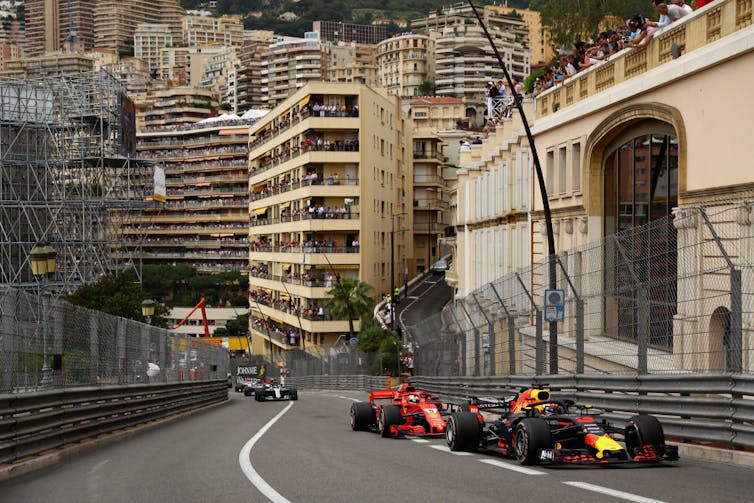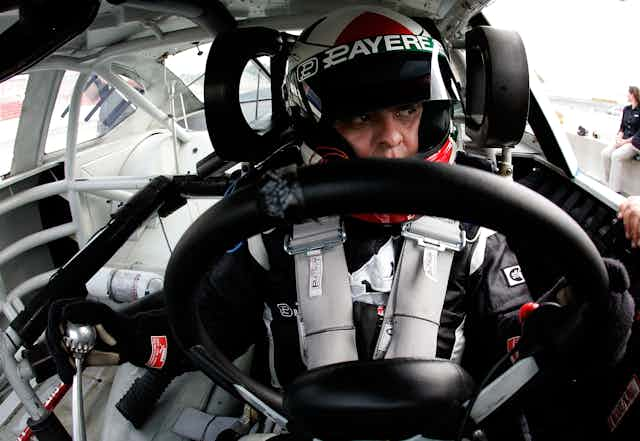Imagine an NBA game played outdoors. In August. In Phoenix. Tip-off is at noon. There are no timeouts. There is no halftime. There are no substitutions. And players must wear snowsuits, gloves, and ski masks.
Sounds ridiculous, right?
Yet race car drivers routinely compete under similar conditions.
On July 1, 2023, for the first time in over 60 years, NASCAR, the nation’s premier stock car series, will hold a race on the streets of a U.S. city at the Grant Park 220 in Chicago.
The fans who attend are sure to appreciate the sound, speed and spectacle. But how many truly grasp the physical and mental strain placed on the drivers?
Our research team from the University of Florida and Michigan State University is collaborating with NASCAR to better understand the stressors drivers experience on the track.
We’ve learned that professional drivers need extraordinary physical and mental stamina to compete in major racing series such as NASCAR, IndyCar and Formula One. Our data shows the metabolic demands of auto racing and basketball are similar. But unlike other athletes, race car drivers compete in full-body safety gear while sitting in a piping hot car for hours at a time.
Not your mom’s minivan
Race car drivers face unique challenges that require strength, endurance and hand-eye coordination.
First, the physical effort of driving a race car is much greater than that of driving your family car.
Turning and braking require more force due to the high speeds and the unique engineering of race cars. Drivers control the vehicle by constantly engaging the muscles of the arms, upper body and legs.
“There’s tremendous kick-back through the steering wheel,” IndyCar driver Dario Franchitti said in a 2012 interview, “and there’s no power steering, so every movement of the wheel requires a lot of energy.”
After being hooked up to sensors to track the stresses and strains he endured a race, Franchitti learned he needed to generate 35 pounds of force just to steer, and 135 pounds of force to brake.
“Imagine a string tied to your hand where you have to pull that 35 pounds up or down constantly,” he added.
Also, fast turns and abrupt braking create accelerative forces, known as G-forces. Like a jet fighter pilot in a dogfight, intense G-forces make it hard for racers to maintain their posture and promote muscle fatigue. It can even become impossible to hold their heads up.
For these reasons, drivers undergo rigorous training to strengthen key muscle groups in the neck, upper body and legs while working to improve their cardiovascular fitness.
Heat is also a major challenge for driver athletes. Like any exercise, the work of driving a race car causes the body to generate metabolic heat. In most sports, athletes wear lightweight clothes that promote cooling by convection and sweat evaporation.
Not so in auto racing. Driver body heat is trapped by the safety gear worn during competition to protect against fire in case of a crash. The gear includes long fireproof undershirt and underpants, full-body fire suit, socks and driving shoes, gloves, a fireproof balaclava, and a full-face helmet with closed eye shield.
Bodies pushed to the limit
To make matters worse, drivers compete in what’s essentially a moving oven.
A massive amount of heat is generated by the race car engine, exhaust, brakes and tires. These sources heat the cockpit and the driver, especially in cars with roofs like stock cars. In summer, cockpit temperatures can exceed 135 degrees Fahrenheit (57 Celsius), leading to profuse sweating, dehydration and even heatstroke.
Most race cars lack air conditioning. Instead, technologies used to combat the heat include hoses that bring fresh air into driver helmets and cool-shirts worn by drivers. In-car drink systems can also provide fluids for re-hydration.
Drivers and other endurance athletes metabolize oxygen to power their muscles and regulate body temperature. Comparing data across sports, my colleague and I found that metabolic demands of auto racing are similar to basketball, soccer or boxing.
Delivering more oxygen to the driver’s body puts stress on the heart. Drivers often maintain near-maximal heart rates while racing for hours at a time.
Beyond the heat, other aspects of racing also put demands on the heart.
First, there is speed. The faster a race car is driven on a given track, the higher the driver’s heart rate due to greater physical and mental effort. Configuration of the race track is also important. Compared to oval tracks, heart rates are higher on road courses and street races. This reflects the extra work required for hard braking and sharp turns.

The mental stress of competition, compounded by the imminent risk of serious injury, can make the heart beat like a jackhammer. Weather can also play a role. This is especially true during the hot days of summer when the heart works harder to regulate driver body temperature. Even the race car contributes: Beyond the hot cabin environment, the car creates vibrations that also stimulate the heart to beat faster.
The race in Chicago will feature all of these challenges, putting extreme stress on drivers. Drivers will be racing closed-cockpit cars wheel-to-wheel through the twists and turns of an unfamiliar street course in the heat of midsummer. These athletes must endure all of these challenges for two hours or longer, while racing 220 miles (354 kilometers) at speeds exceeding 100 mph (161 kph).
While the outcome is unpredictable, the drivers will be pushing their bodies – in addition to their cars – to their limits.

